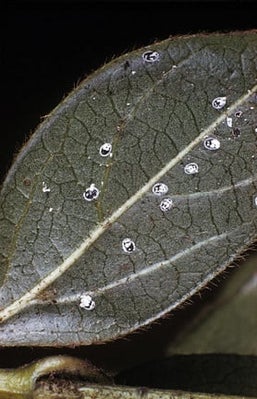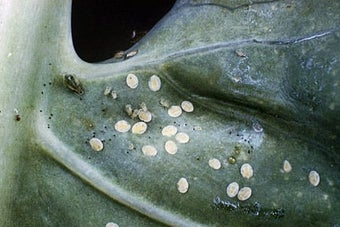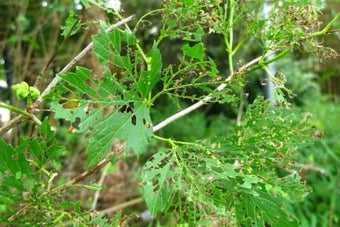
Quick facts
Common name - Viburnum whitefly
Sientific name - Aleurotuba jelinekii
Plants affected - Viburnum tinus and Arbutus spp.
Main symptoms - Small white-winged insects on foliage in summer, black and white scale-like pupae on underside of leaves in winter
Caused by - A sap-sucking insect
Timing - All year
What is viburnum whitefly?
Whiteflies are sucking true bugs (Hemiptera) in the family Aleyrodidae. The adults are typically white and fly up from host plants when disturbed. There are around eight species found in Britain, some are restricted to a limited host range others are found indoors on a wide range of plants.
Viburnum whitefly feeds on the underside of the leaves on Viburnum tinus and sometimes on strawberry trees, Arbutus spp. Often with no noticeable effect on the host plants health. This insect should not be confused with other species of whitefly such as glasshouse whitefly which rarely affects these plants or cabbage whitefly which is only found on brassicas.
Symptoms
Check plants for:
- Small white-winged insects, about 1 mm long, living on the underside of younger leaves in mid-summer
- In winter, the insect is present as the overwintering scale (nymph) stage. These are black, oval, scale-like objects that are 1 mm long and encrusted with a white waxy powder
- Usually host plant health is unaffected. Occasionally large populations develop which can lead to sooty mould on the upper leaf surface where the insect’s sugary honeydew excrement has accumulated
Management
- This whitefly rarely affects the growth or vigour of host plants and so it can be accepted as part of the that viburnum and Arbutus support
- Encourage predators and other natural enemies of whitefly, in the garden, such as birds, ladybirds, wasps and ground beetles
Biology
Viburnum whitefly has one generation a year.
The adults emerge in mid-summer, when they deposit eggs on the underside of leaves near the shoot tips. These hatch into flat, oval whitish-green nymphs (sometimes called larvae) that suck from the lower leaf surface.
By autumn, the nymphs have reached the pupal stage, which is black and encrusted with a white waxy powder. Both adults and nymphs produce a sugary excrement, called honeydew, which makes the foliage sticky and can allow the growth of .




